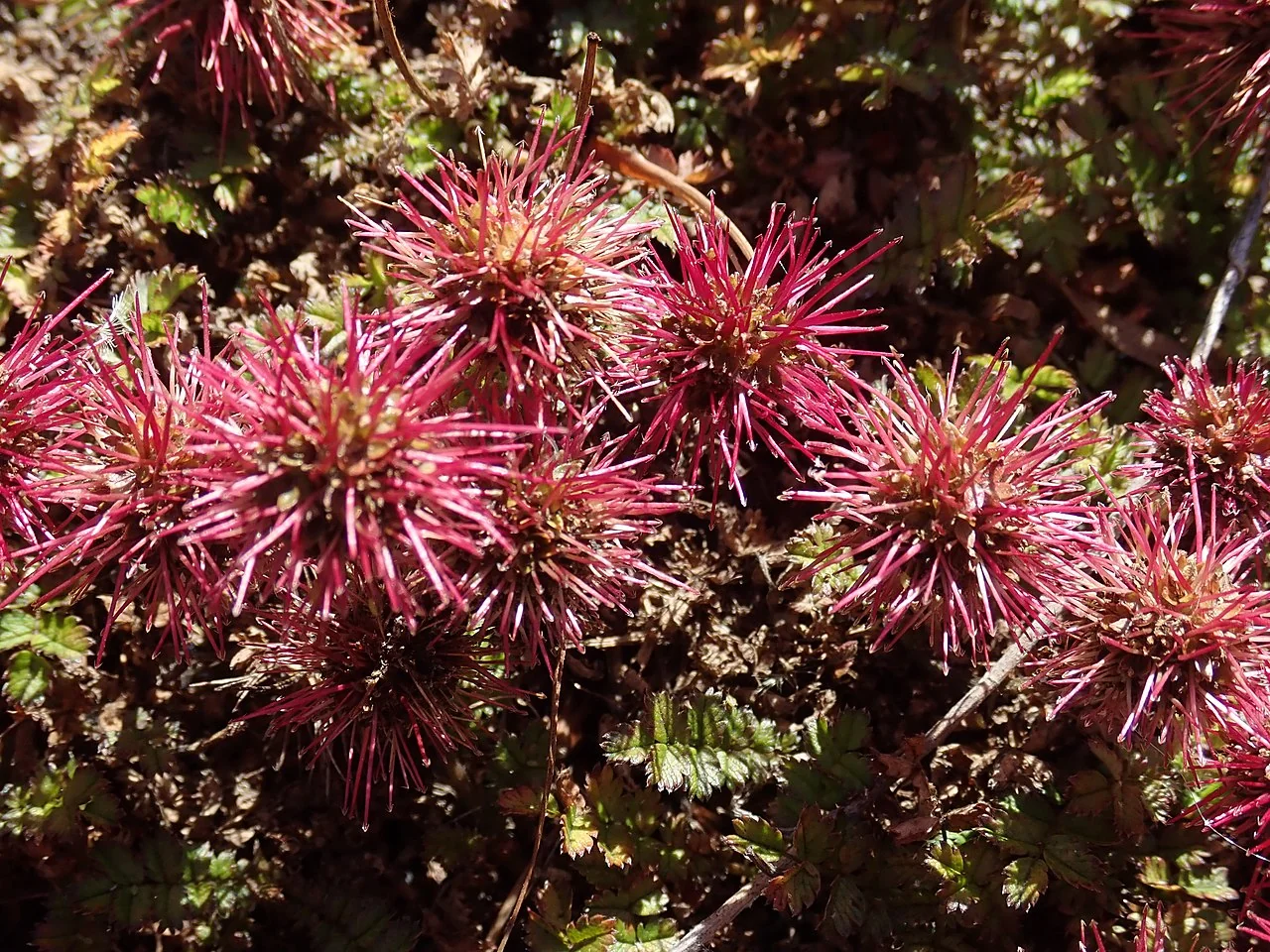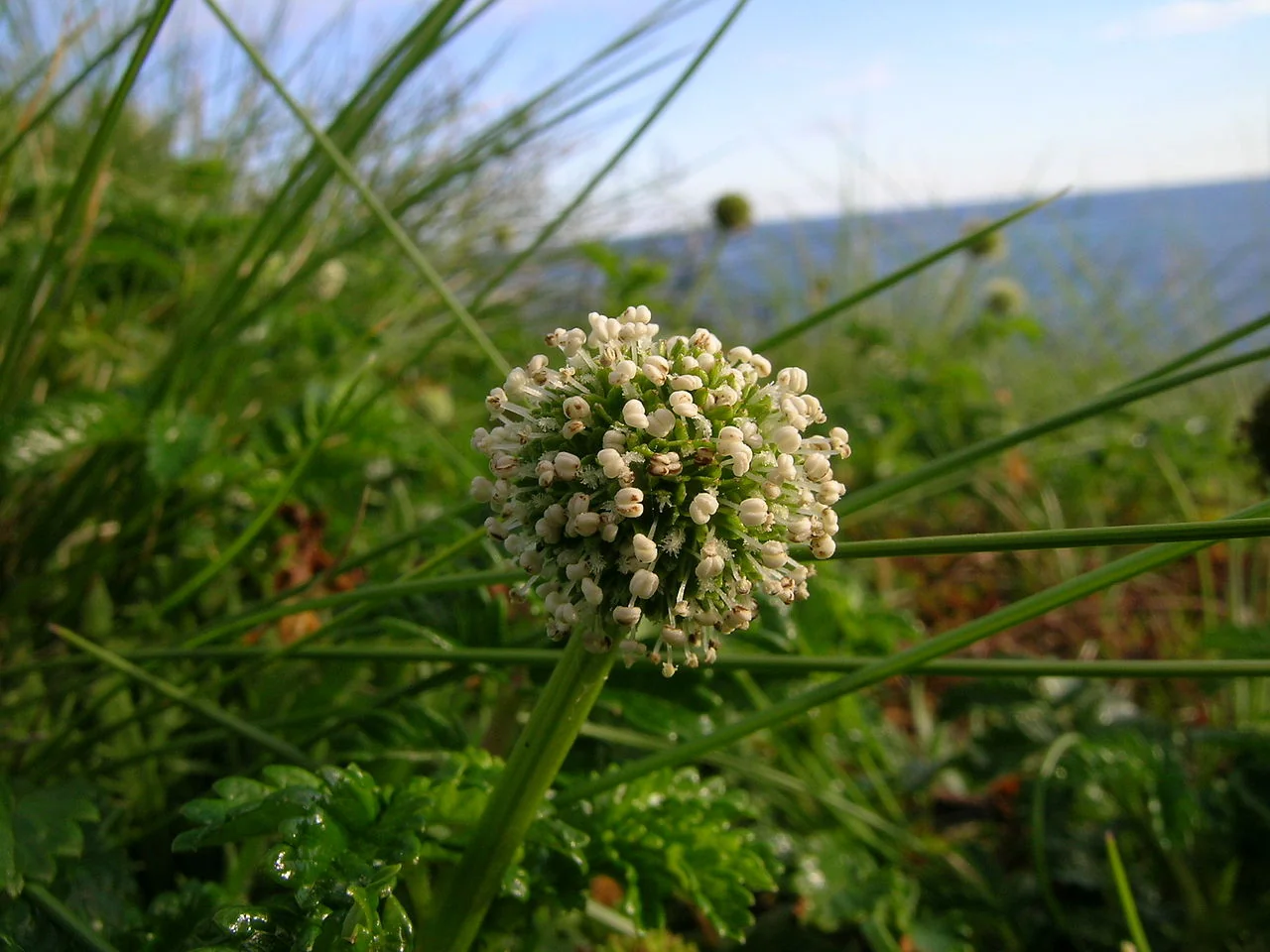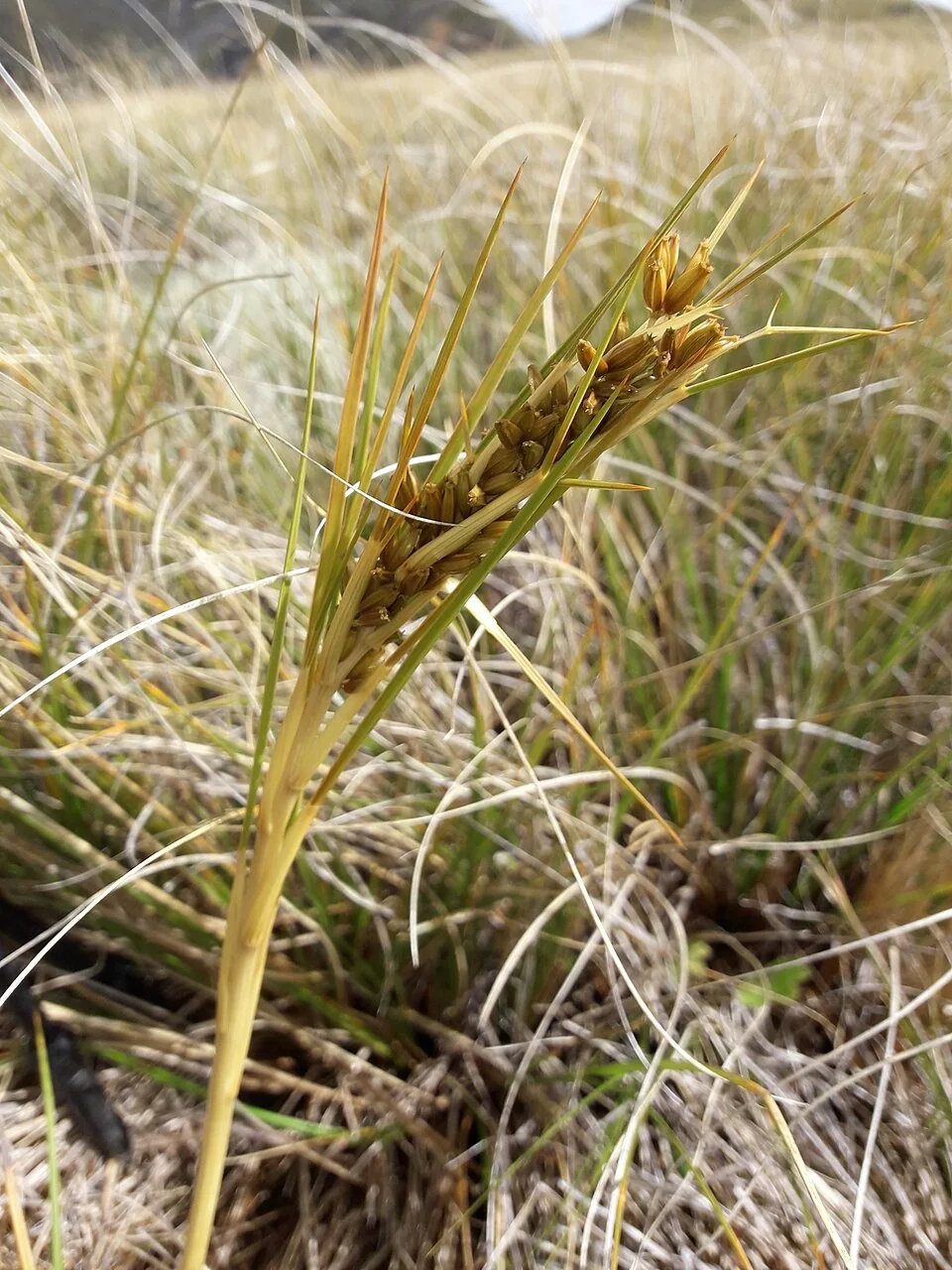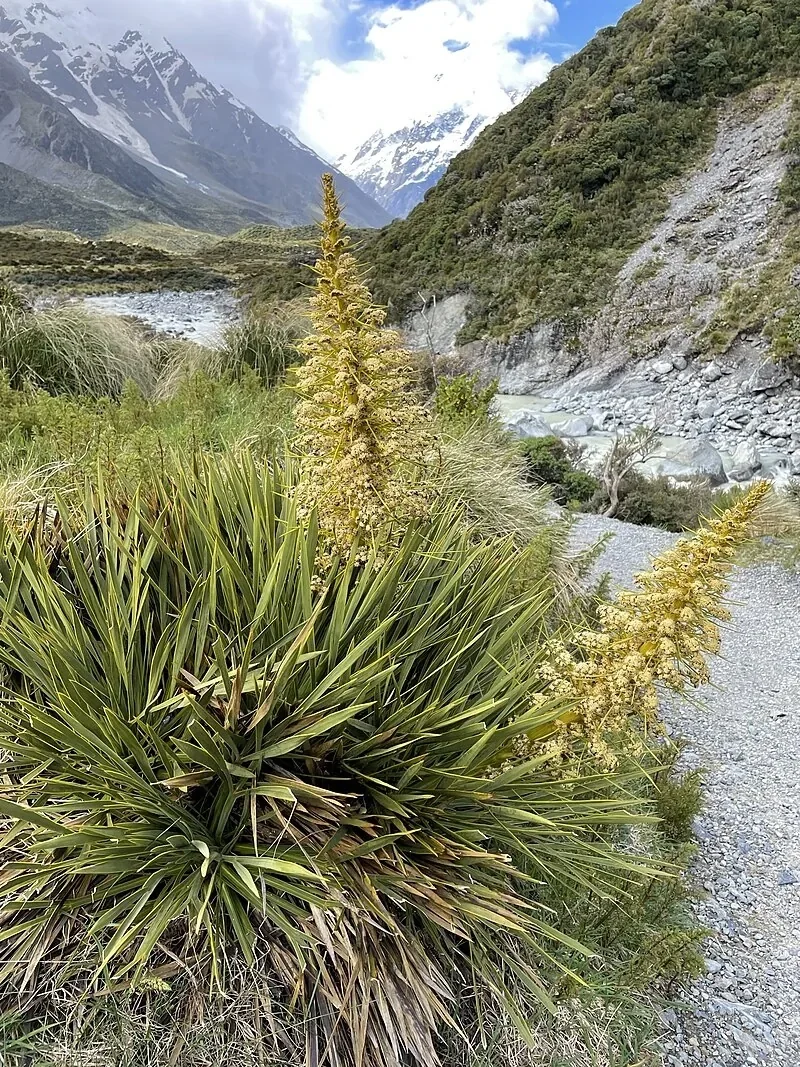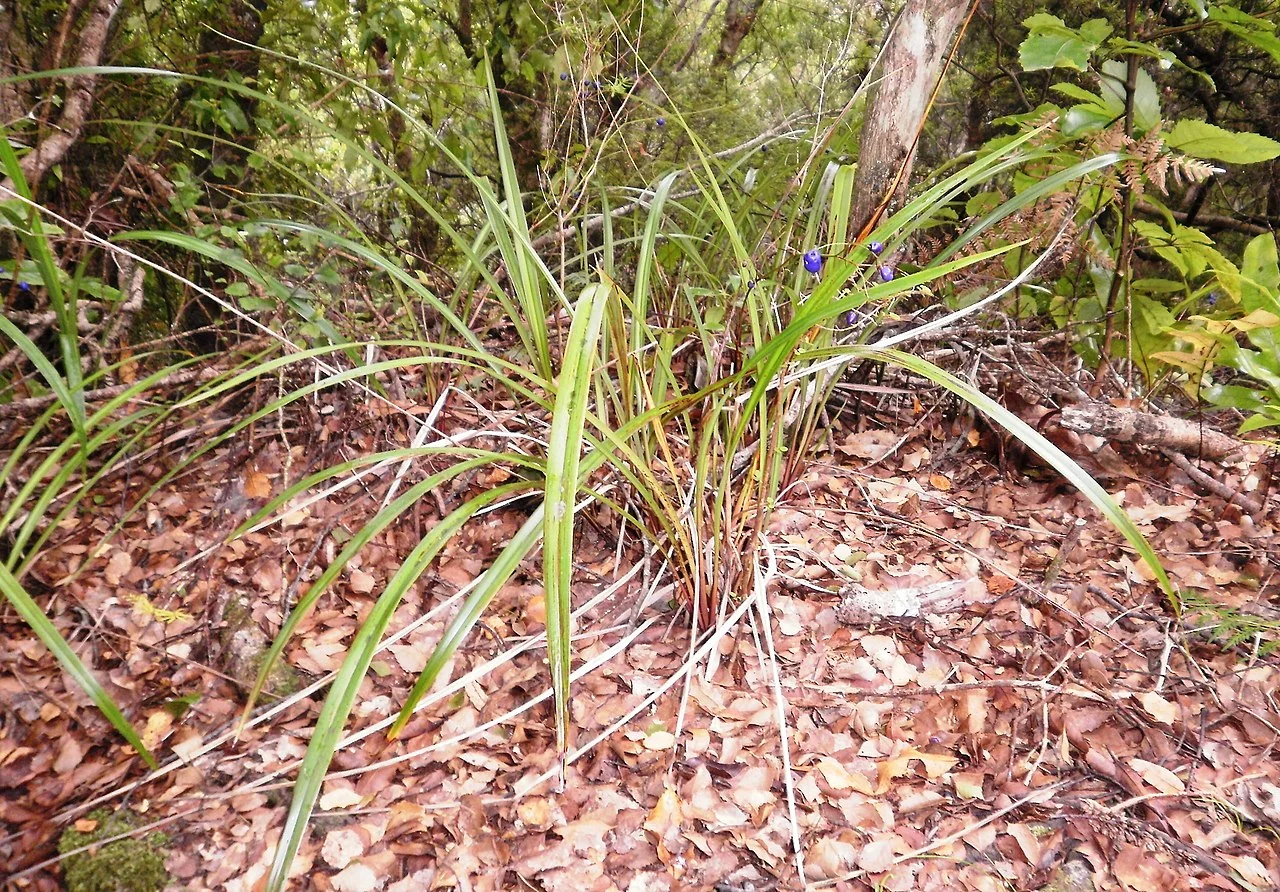
Tūrutu
Dianella nigra
Tūrutu ( Dianella nigra ) stands as one of New Zealand's most charming and useful native flowering plants , creating elegant displays of fountain-like foliage crowned with spectacular displays of jewel-bright berries that have earned it the delightful nickname "New Zealand blueberry." This graceful endemic herb forms attractive clumps of long, arching leaves that create a distinctive architectural presence in the garden, while its remarkable adaptability allows it to thrive in environments ranging from deep forest shade to open sunny banks. The plant's most celebrated feature lies in its extraordinary berries - glossy, round fruits that ripen from green to brilliant blue, purple, or deep violet-black, creating such intense colours that they appear almost artificial in their vibrancy. These berries were historically significant to Māori communities, who discovered that when crushed, they yielded a rich, ink-like juice perfect for tattooing and dyeing, giving the plant its alternative name "inkberry" and contributing to its scientific name "nigra," referring to the dark pigments. The delicate star-shaped flowers that precede these berries add their own charm to the display, opening in pale purple to blue-violet with bright yellow centers in the early morning before closing each afternoon, creating a daily rhythm that connects gardeners to the plant's natural cycles. Found naturally throughout New Zealand from coastal areas to montane forests up to 760 meters elevation, Tūrutu demonstrates remarkable ecological versatility, colonizing forest clearings, stream banks, and rocky outcrops with equal enthusiasm. The plant's strong rhizome system enables it to form stable colonies that help prevent soil erosion while providing crucial food resources for native birds including kererū, tūī, and bellbirds, whose feeding activities help disperse seeds and maintain genetic diversity across fragmented forest landscapes. In cultivation, this low-maintenance perennial has become increasingly popular for its ability to provide year-round interest with minimal care, thriving in partial shade with regular moisture while tolerating surprising amounts of drought and full sun once established.

Plant Description
Botanical Features
Dianella nigra , commonly known as Tūrutu, New Zealand Blueberry, or Inkberry, is a perennial herb endemic to New Zealand. It forms loose tussocks or dense clumps with strong, well-developed rhizomes, typically growing between 30 and 90 cm tall and up to 50 cm wide. Its leaves are long, narrow, and strap-like, measuring 250-800 mm in length and 12-18 mm in width, and are typically yellow-green to green, sometimes with red spots, arching gracefully. Small, star-shaped flowers, approximately 1-2 cm in diameter, appear from early spring to mid-summer, ranging in colour from white to pale purple or blue-violet, often with a distinct yellow centre. The most ornamental feature is its fruit: glossy, round berries that are 5-10 mm in diameter, turning brilliant blue to purple-black when mature, typically appearing between January and April. This hardy plant is found in open forests and on banks from sea level to 760 m throughout New Zealand, preferring semi-shade with moist soil but tolerating full sun and dry conditions once established.
Quick Facts
| Scientific Name | Dianella Nigra |
|---|---|
| Height | 0.8-1.5 m |
| Spread | 0.8-1.2 m |
| Water Needs | Low to moderate |
| Light | Full sun to part shade |
| Frost Tolerance | Good |
| Salt Tolerance | Moderate |
| Growth Rate | Moderate |
| Lifespan | Long |
Climate Best Suited to
Tūrutu ( Dianella nigra ) adapts well to various conditions from coastal to inland areas, preferring areas with consistent moisture. It adapts well to typical New Zealand growing conditions with appropriate care and positioning.
Regional Suitability
| Whangārei | Ideal |
| Auckland | Ideal |
| Hamilton | Suitable |
| Rotorua | Suitable |
| Tauranga | Ideal |
| Gisborne | Ideal |
| New Plymouth | Ideal |
| Whanganui | Ideal |
| Palmerston North | Suitable |
| Napier | Ideal |
| Wellington | Ideal |
| Nelson | Ideal |
| Christchurch | Suitable |
| Dunedin | Suitable |
| Invercargill | Suitable |
| City | Climate Suitability |
|---|
Natural Habitat
Tūrutu is a remarkably adaptable plant, found in a wide range of habitats throughout New Zealand, from the coast to subalpine regions. It is a common component of lowland and montane forests, where it can be found in the understory, along track edges, and in clearings. It also grows in coastal shrublands, on cliff faces, and in gumland scrub. This versatility is a testament to its resilience and ability to thrive in various soil types and light conditions, although it prefers moist, well-drained soil and semi-shade.
Plant Conservation
Dianella nigra , commonly known as Tūrutu, New Zealand blueberry, or inkberry, is a perennial herb endemic to New Zealand. It is currently classified as "Not Threatened" under the New Zealand Threat Classification System (NZTCS), a status it has held consistently since at least 2004. This indicates that the species is not considered at risk of extinction in its natural habitat. Tūrutu is widespread throughout New Zealand, found in open forests and on banks from sea level to 760 m. It is a remarkably adaptable plant, thriving in a wide range of habitats and tolerating various soil types and light conditions. While not threatened, its ecological importance lies in providing food for native birds through its spectacular blue berries and contributing to soil stability with its strong rhizome system. Conservation efforts for native plants in New Zealand generally focus on protecting natural habitats from invasive species and promoting biodiversity, which indirectly benefits widespread species like Tūrutu.
Growing Requirements
Soil Requirements
Tūrutu ( Dianella nigra ) performs best in well-draining soil that retains adequate moisture. Like most New Zealand natives, it prefers soils that don't become waterlogged but maintain consistent moisture levels. Good drainage is essential for healthy root development.
- Well-draining soil essential for healthy growth
- Prefers consistent moisture without waterlogging
- Adapts to various soil types with good drainage
- Benefits from organic matter incorporation
- Mulching helps retain moisture and suppress weeds
Light Requirements
Tūrutu ( Dianella nigra ) performs well in full sun to partial shade conditions. Like many New Zealand natives, it adapts to various light conditions but typically shows best growth and form in positions that receive adequate sunlight throughout the day.
- Full sun to partial shade positions
- At least 4-6 hours of direct sunlight daily
- Tolerates light shade in warmer climates
- Morning sun particularly beneficial
Water Requirements
Tūrutu ( Dianella nigra ) requires regular watering during establishment, typically for the first 1-2 years. Once established, it becomes more drought-tolerant but benefits from consistent moisture during dry periods. Avoid overwatering which can lead to root problems.
- Regular watering during establishment phase
- Moderate drought tolerance once established
- Consistent moisture during dry periods beneficial
- Avoid waterlogged conditions
- Mulching helps conserve soil moisture
Planting Guide
Tūrutu is a hardy and adaptable plant that is easy to establish in a garden setting. Its attractive foliage and stunning berries make it a rewarding plant to grow. Following a few simple guidelines will ensure your Tūrutu thrives.
Site Selection
- Light: Tūrutu is very adaptable, growing well in conditions ranging from full sun to semi-shade. For the best foliage colour and berry production, a position with some sun is ideal. In very hot climates, some afternoon shade will be beneficial.
- Soil: This plant prefers a moist, well-draining soil. It is tolerant of a wide range of soil types, but will not do well in soils that are constantly waterlogged.
- Location: Tūrutu is perfect for mass planting under trees, as a border plant, or in a mixed native planting. Its spreading habit makes it an excellent groundcover.
Planting Instructions
- Timing: The best time to plant Tūrutu is in the autumn or spring, when the soil is moist and warm.
- Planting: Dig a hole that is twice the width of the root ball. Gently remove the plant from its container and place it in the hole. Backfill with soil, ensuring the plant is at the same level as it was in the container. Water in well.
Ongoing Care
- Watering: Water regularly during the first year to help the plant establish. Once established, Tūrutu is reasonably drought-tolerant, but will benefit from a deep watering during prolonged dry spells.
- Mulching: Apply a layer of mulch around the plant to help retain moisture and suppress weeds.
- Pruning: Tūrutu requires very little pruning. Simply remove any old or dead leaves to keep the plant looking tidy.
Ecological Role
Environmental Benefits
Tūrutu or New Zealand blueberry ( Dianella nigra ) is a hardy understorey species of coastal to lowland forest and scrub. In summer it bears starry white to pale-blue flowers that provide nectar and pollen for small native insects. Through late season and into autumn, vivid indigo berries are eaten and dispersed by birds and occasionally lizards, moving seed into forest margins and gaps.
- Understorey stabiliser: Rhizomatous clumps bind leaf litter and fine soil on shaded banks and tracks.
- Food resource: Berries attract small frugivores; staggered fruiting extends availability late in the season.
- Edge coloniser: Tolerates wind and light salt, helping to re‑vegetate coastal shrubland edges.
- Refugia: Dense, strap‑like leaves create humid microhabitats for invertebrates on the forest floor.
Uses and Significance
Garden Uses
- Excellent for native plant gardens and restoration
- Suitable for naturalistic landscape designs
- Low maintenance once established
- Contributes to local biodiversity
- Attractive to beneficial native wildlife
Cultural Significance
Traditional Uses and Values
Dianella nigra , also known as Tūrutu, New Zealand blueberry, or inkberry, holds significant cultural importance, particularly for the Māori people of New Zealand.
- Dye Production: The vibrant blue berries of Dianella nigra were traditionally used by Māori to produce a blue dye. This dye was possibly used for tattooing practices, such as tā moko. The striking colour of the berries may have imbued the plant with tapu (sacred) qualities.
- Weaving: While flax (harakeke) was preferred, the fibrous leaves of Dianella nigra were occasionally used for weaving small items.
- Bird Calls: Māori fowlers used tūrutu leaves to create pepe (bird calls). They would fold a leaf into a tube and blow through it to produce a loud noise to attract birds.
- Traditional Knowledge: The Māori name "tūrutu" itself signifies its place in traditional ecological knowledge and contributes to New Zealand's botanical heritage.
Although the berries resemble blueberries, they are not a food source due to their bitterness and potential toxicity.
Landscaping Uses
Tūrutu is a highly versatile and low-maintenance plant, making it a popular choice for a wide range of landscaping applications. Its attractive, flax-like foliage, delicate flowers, and stunning blue berries provide year-round interest in the garden.
Key Landscaping Uses:
- Groundcover and Mass Planting: The spreading nature of Tūrutu makes it an excellent groundcover, particularly in dry, shaded areas where other plants may struggle. It can be mass-planted to create a lush, textured carpet of foliage.
- Borders and Edging: Its clumping habit and graceful, arching leaves make it an ideal plant for edging paths and garden beds, providing a soft, naturalistic border.
- Native and Restoration Plantings: As a native plant that provides a valuable food source for birds, Tūrutu is an essential component of any native garden or ecological restoration project.
- Container Gardening: Tūrutu can be successfully grown in pots and containers, making it a great choice for patios, balconies, and smaller gardens.
- Underplanting: It is an excellent choice for underplanting larger trees and shrubs, where it will thrive in the dappled light.
With its adaptability and attractive appearance, Tūrutu is a valuable addition to any New Zealand garden, whether you are creating a formal border or a wild, naturalistic landscape.
Seasonal Care Calendar
Spring
Spring is an active growth period for Tūrutu ( Dianella nigra ). New growth emerges and this is an ideal time for planting new specimens. Monitor soil moisture as temperatures warm and growth accelerates.
- Active growth period with new foliage development
- Ideal time for planting new specimens
- Monitor soil moisture as temperatures rise
- Apply organic mulch if needed
Summer
Summer is typically the main growing season for Tūrutu ( Dianella nigra ). Ensure adequate watering during hot, dry periods, especially for young plants. Established plants show good heat tolerance with appropriate care.
- Peak growing season with active development
- Monitor watering needs during hot weather
- Young plants need consistent moisture
- Established plants show good heat tolerance
Autumn
During autumn, Tūrutu ( Dianella nigra ) begins to slow its growth as temperatures cool. This is another good time for planting as conditions become more favorable. Reduce watering frequency but maintain soil moisture.
- Growth slows as temperatures moderate
- Good time for planting new specimens
- Reduce watering frequency gradually
- Maintain soil moisture without overwatering
Winter
Winter is typically a dormant period for Tūrutu ( Dianella nigra ), with minimal growth activity. Reduce watering but ensure plants don't completely dry out. Most New Zealand natives are cold-hardy and require minimal winter protection.
- Dormant period with minimal growth activity
- Reduce watering but avoid complete drying
- Generally cold-hardy in most New Zealand climates
- Minimal winter protection required
When to Prune and How Much
Tūrutu ( Dianella nigra ) generally requires minimal pruning to maintain its natural form and health. Most maintenance involves removing dead or damaged growth and light shaping if needed.
- Remove dead, damaged, or diseased growth as needed
- Light pruning to maintain shape if desired
- Prune after flowering if applicable
- Avoid heavy pruning which can stress the plant
- Use clean, sharp tools to prevent disease
- Most natives maintain good form without regular pruning
Always use clean, sharp tools when pruning to minimize disease risk. Native plants typically maintain their natural form well and often require less intervention than exotic species.
How to Grow Tūrutu
Tūrutu, also known as New Zealand Blueberry or Inkberry, is a charming and versatile native perennial that adds year-round interest to any garden with its arching, strap-like foliage and spectacular blue berries. It is a relatively easy plant to grow, adapting well to a variety of conditions from full sun to partial shade, and tolerating both dry periods and consistent moisture once established. Its low-maintenance nature and ecological value, providing food for native birds and traditional dye, make it an excellent choice for native gardens, borders, and mass plantings.
From Seed
Propagating Tūrutu from fresh seed is a reliable method. Collect the brilliant blue berries when they are ripe, typically in late summer or autumn. Clean the seeds thoroughly to remove the fleshy pulp. Sow the seeds onto a well-draining seed-raising mix, lightly covering them with a thin layer of fine grit or sand. Maintain consistent moisture in the seed tray and provide warm, bright conditions for germination. Germination typically occurs within 4-8 weeks, but can sometimes be erratic. Once seedlings have developed a few true leaves and are large enough to handle, they can be carefully transplanted into individual pots and grown on in a sheltered location before planting out into the garden.
From Division
Established Tūrutu clumps can be easily divided, especially in late winter or early spring before new growth begins. This method is excellent for rejuvenating older, overgrown plants and for creating new plants that are genetically identical to the parent. Carefully dig up the entire clump, or a section of it, using a sharp spade. Divide the clump into smaller sections, ensuring each section has a healthy portion of roots and several shoots. Replant the divisions immediately into well-prepared soil, ensuring they are planted at the same depth as the original plant. Water thoroughly after planting and keep consistently moist until established. This method is particularly effective for quickly increasing your stock of Tūrutu.
Pests and Diseases
Common Problems and Solutions
Tūrutu ( Dianella nigra ) is generally trouble-free, but slugs and snails may graze tender new fans in damp, shaded beds. In containers, ensure sharp drainage to avoid crown rot; a gritty, organic mix and watering at the base keeps the leaf bases dry. Plants are tolerant of salt-laden winds and rarely suffer foliar scorch except in extreme heat.
Bonus Tip
Expert Growing Advice
The deep blue fruits of Dianella nigra were traditionally used as a source of dye. If you-re growing it near paving, be aware the berries can stain - harvest a few for small natural-dye projects and deadhead the rest to keep paths clean while still feeding birds elsewhere in the garden.




